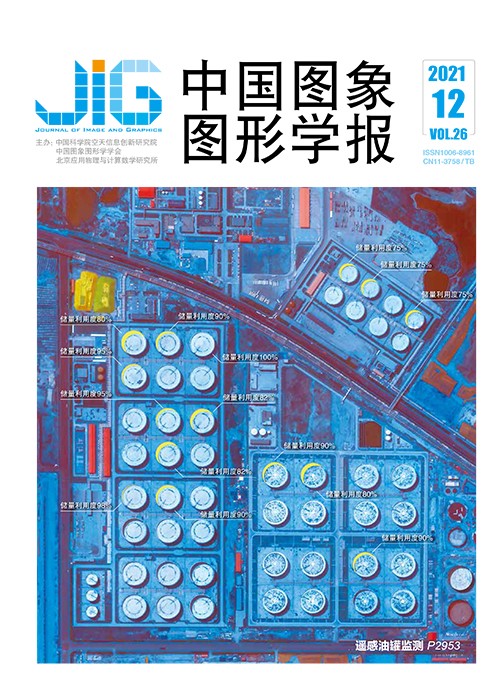
改进U-Net型网络的遥感图像道路提取
摘 要
目的 遥感图像道路提取在城市规划、交通管理、车辆导航和地图更新等领域中发挥了重要作用,但遥感图像受光照、噪声和遮挡等因素以及识别过程中大量相似的非道路目标干扰,导致提取高质量的遥感图像道路有很大难度。为此,提出一种结合上下文信息和注意力机制的U-Net型道路分割网络。方法 使用Resnet-34预训练网络作为编码器实现特征提取,通过上下文信息提取模块对图像的上下文信息进行整合,确保对道路的几何拓扑结构特征的提取;使用注意力机制对跳跃连接传递的特征进行权重调整,提升网络对于道路边缘区域的分割效果。结果 在公共数据集Deep Globe道路提取数据集上对模型进行测试,召回率和交并比指标分别达到0.847 2和0.691 5。与主流方法U-Net和CE-Net(context encoder network)等进行比较,实验结果表明本文方法在性能上表现良好,能有效提高道路分割的精确度。结论 本文针对遥感图像道路提取中道路结构不完整和道路边缘区域不清晰问题,提出一种结合上下文信息和注意力机制的遥感道路提取模型。实验结果表明该网络在遥感图像道路提取上达到良好效果,具有较高的研究和应用价值。
关键词
Road extraction method from remote sensing images based on improved U-Net network
Yang Jialin1, Guo Xuejun2, Chen Zehua2(1.College of Electric and Power Engineering, Taiyuan University of Technology, Taiyuan 030024, China;2.College of Data Science, Taiyuan University of Technology, Taiyuan 030024, China) Abstract
Objective Road extraction from remote sensing images has played an important role in city planning, traffic management, vehicle navigation, map updating and other fields nowadays, the characteristics of the road area in the remote sensing image have been affected by many factors such as lighting, noise and occlusion in the image acquisition process. A huge number of similar non-road objects, such as building areas and water areas have interfered with the road area recognition process simultaneously. The above two factors have increased the difficulty of road extraction from remote sensing images. Supervised learning-based road extraction algorithms such as support vector machines and traditional artificial neural networks have to artificially design features so as to train classification models. The recognition rate of these traditional methods has been significantly decreased when facing with the interference of the similar non-road targets and the rich information of the background in the images. Recently, a variety of deep learning techniques of convolutional neural networks have been widely used in the field of remote sensing image processing based on its efficient feature learning ability. Deep learning network has made a great progress in road extraction. It can not only obtain the overall network structure of the road, but also the clear boundaries of the road. A U-Net road segmentation network has been proposed improve the road extraction quality based on the context information and attention mechanism. Method A novel deep neural network for road extraction from remote sensing images has been proposed based on the symmetrical structure of U-Net network and attention mechanism. In the network structure, the introduction of the pre-trained Resnet-34 network can effectively extract image features at different granularities. Resnet-34 residual network has been used as the backbone network of the novel U-Net network. Residual learning can greatly reduce the training time of the deep network, avoid the phenomenon of gradient disappearance, and improve the training accuracy. Meanwhile, the context information has contained the interaction information between different objects, the interaction information between the object and the scene, which can be used as features to combine the various parts between the roads and distinguish the road and the background. The context information extraction module can integrate the context information to ensure that the geometric topology of the road is extracted in the image. To adjust the feature weights, the attention mechanism module can be transmitted by the skip connection, strengthened by the feature information of the road area, suppressed by the feature information of the non-road area improved by the segmentation effect of the road edge thereby effectively improving the accuracy of road segmentation. The improved model has resolved the incomplete and disconnected road structure to a certain extent by adding the context information extraction module. Furthermore, the decoder combined attention mechanism has been used to adjust the feature weights of skip connections to improve the segmentation effect of the road edge area. Combining attention mechanism and context information extraction module can effectively use global and local remote sensing image information to improve the road extraction performance. Result The model on the Deep Globe 2018 road extraction challenge dataset has been tested to evaluate the performance of the proposed model quantitatively. The Deep Global satellite road extraction dataset has contained 6 226 pairs of RGB satellite remote sensing images and labeled with dimension of 1 024×1 024 pixels. The dataset has been divided into 5 500 training set and 726 test set in the experiments. In order to evaluate the performance of the road segmentation model, two semantic segmentation performance indices have been commonly used in remote sensing image road segmentation:recall rate (recall) and intersection over union (IOU). The comprehensive experiments have shown that the recall rate and intersection over union of the proposed algorithm for the Deep Globe 2018 road extraction challenge dataset reached 0.847 2 and 0.691 5, respectively. The proposed model can segment a continuous road network. At the same time, the missing location information has been effectively restored to make the edges of the road clearer. The proposed algorithm can improve the use of remote sensing image information by adding context information module and attention mechanism. Compared with U-Net,context encoder network(CE-Net) and other models, it has higher accuracy and robustness. Conclusion A road extraction model for remote sensing images combined context information and attention mechanism has been proposed. The novel model has benefited from its pre-trained Resnet-34 backbone network and utilization of context information. Utilization of context information has solved incomplete and disconnected road structure to a certain extent. The decoder of the attention mechanism has improved the segmentation effect of the road edge area. The experimental results have demonstrated that the network achieved good results of road extraction from remote sensing images. The proposed method has improved the road segmentation accuracy and displayed the potential in remote sensing image processing.
Keywords
|



 中国图象图形学报 │ 京ICP备05080539号-4 │ 本系统由
中国图象图形学报 │ 京ICP备05080539号-4 │ 本系统由